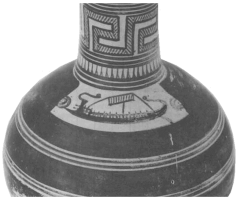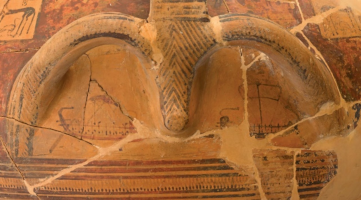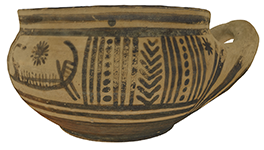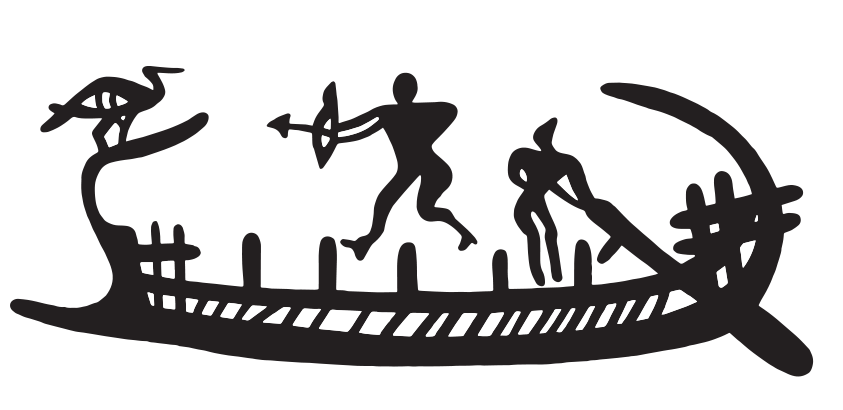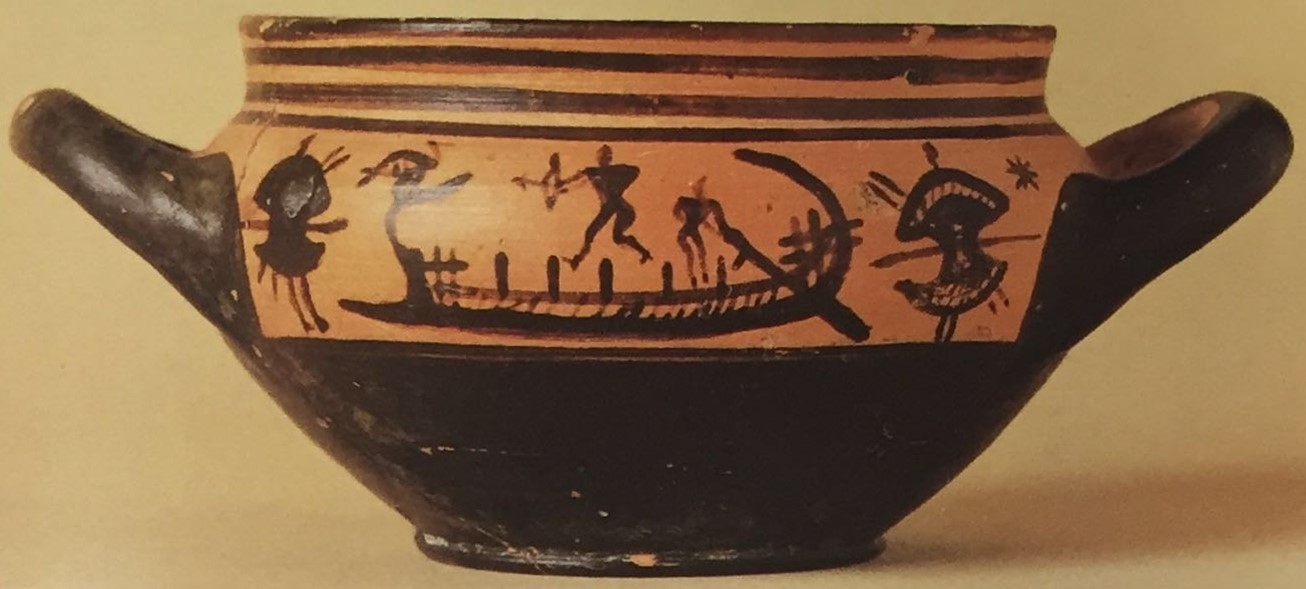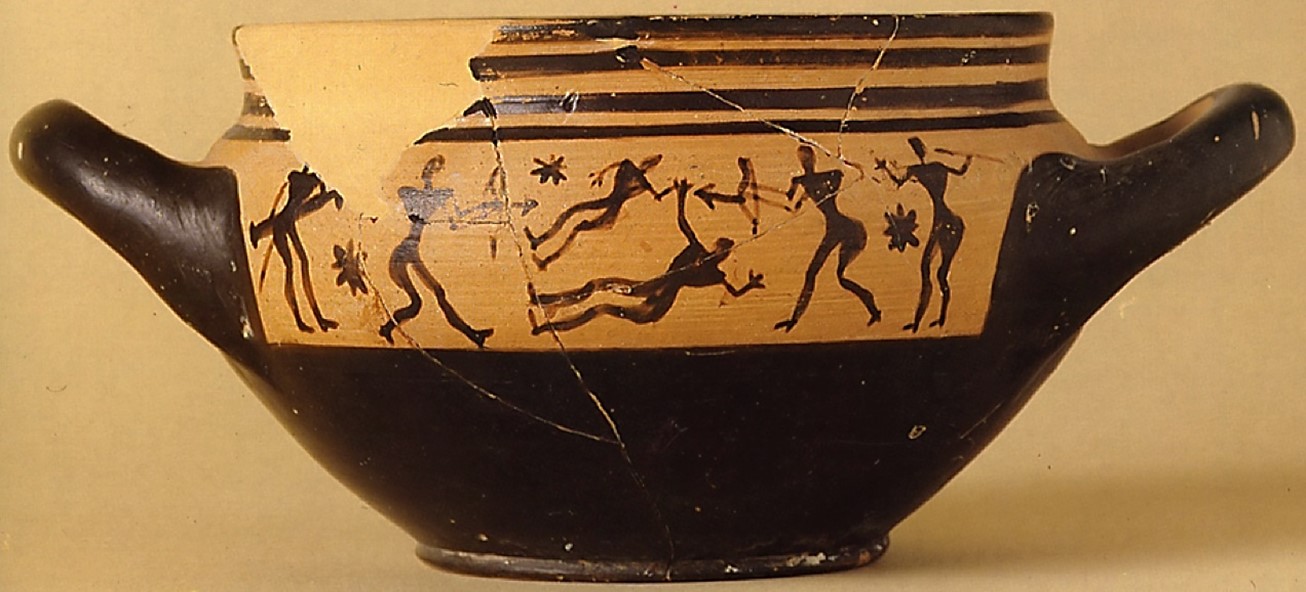Ship to the left with a low flat hull, a vertical semi-integrated stempost (group 3) ending in an incurving horn, and a markedly incurving high sternpost. Forecastle and aftercaste with lattice railings (protective palisade), with the two horizontal planks of the latter protruding behind the sternpost. The bow projection is well-integrated. The horizontal line above the hull represents the railing, as indicated by the five oversized tholepins projecting from it. It is connected to the hull by twenty oblique strokes, which are suspiciously similar to the ones decorating the Dipylon shield of the warrior to the right of the ship. The helmsman operates a large quarter rudder with a tiller.
Two single-levelled galleys
A123
late Middle Geometric II
Eleusis, tomb context
H: 6.4 cm
Attic skyphos
Eleusis 741
Ahlberg 1971: 34-35, no. B11, figs. 42-43; Basch 1987: 175, no. 372; Carter 1972: 34-35, fig. 5c; Kirk 1949: 97-98, no. 3; Morrison and Williams 1968: 33-33, geom. 28, pl. 6d; Stansbury-O'Donnell 2006: 251 (narrative); Tzahou-Alexandri 1990: 334-35, fig.5 ; Wedde 1999a: 511, fig. 6; 2000:169, fig. 16f
Side A: Ship to the left, with a bird perched on its bow, a helmsman operating the steering oar facing right, and a warrior with a bow and a drawn arrow running to the left amidships. The ship is flanked on either side by a nearly identical warrior facing towards it, each equipped with a Dipylon shield, two spears at an upward angle, and another spear held horizontally at the torso level. There is a seven pointed star behind the right warrior.
Side B: Combat scene with two reclining figures grasping hands in the center, framed on either side by a pair of figures facing them, each group comprised by an archer with a drawn out bow closest to the center and a spearman at the edge of the composition. Three more seven pointed stars interspersed within the scene.
The artist does not appear to have been concerned with the technical accuracy of the ship, either in terms of proportions or detailing. The most obvious indication are the tholepins, which are both oversized and too few. The figures on both sides are furthermore depicted floating in mid air, making them unreliable indicators for the presence of a deck which cannot be securely ascertained, although it has been inferred by Kirk and Casson. Wedde interprets this vessel as open-hulled (Wedde 2006: 261). If the oblique strokes between the rail and the hull are seen through the lens of artistic license, one could argue that in actuality these were rather vertical, thus representing struts that supported a raised rail on which the tholepins were fixed, rather than directly on the gunwale. Wedde interprets them alternatively as the ship's frames. Tzahou-Alexandri argues these are merely a decorative band such as the one seemingly depicted on the warrior's shield, but this interpretation is unlikely (Tzahou-Alexandri1990:334). The length of the ship is impossible to determine due to the problems of proportion.
This skyphos is significant because it represents one of the earliest examples of figural decoration. Although the scenes are definitely narrative in nature, there is an apparent lack of specificity, whether in terms of identifying protagonists, or the outcome of the battles. The symmetry and balance of the figures contributes to this ambivalence, offering a range of possible outcomes and interpretations around the themes of heroic action and death. Giuliani argues that the bowman that is depicted in fact does not represent an individual bowman, but rather a prototypical motif, whose dynamics in action are not situational but attributive features (Giuliani 2003: 67). It is likewise difficult to tell whether the ship is beached, arriving, or departing, since the two static warriors framing it do not seem to be part of the narrative scene itself, but rather as separate decoration similar to the files of warriors depicted on the New York krater.
Ahlberg-Cornell, G. 1971. Fighting on Land and Sea in Greek Geometric Art. Skrifter utgivna av Svenska Institutet I Athen 4, XVI. Stockholm.
Basch, L. 1987. Le musée imaginaire de la marine antique. Athens: Institut Hellénique pour la preservation de la tradition nautique.
Carter, J. 1972. “The Beginning of Narrative Art in the Greek Geometric Period.” BSA 67: pp. 25-58.
Kirk, G.S. 1949. “Ships on Geometric Vases.” BSA 44: 93-153, pls. 38-40.
Morrison, J.S. and R.T. Williams. 1968. Greek Oared Ships: 900-322 B.C. Cambridge: Cambridge University Press.
Stansbury-O'Donnell, M. D. 2006. “The Development of Geometric Pictorial Narrative as Discourse,” in E. Rystedt and B. Wells (ed.) Pictorial Pursuits: Eigurative Painting on Mycenaean and Geometric Pottery. Paper from Two International Round-Table Conferences on Mycenaean and Geometric Pottery at the Swedish Institute at Athens in 1999 and 200. Stockholm: Svenska Instituted I Athen, pp. 247-253.
Tzahou-Alexandri, O. 1990. “Contribution to the knowledge of 8th century B.C. Ship Representations,” in H.E. Tzalas (ed.) Tropis II: 2nd International Symposium on Ship Construction in Antiquity. Delphi 1987 (Hellenic Institute for the Preservation of Nautical Tradition). Athens: Hellenic Institute for the Preservation of Nautical Tradition, pp. 333-61.
Wedde, M. 1999a. “Decked Vessels in Early Greek Ship Architecture,” in H.E. Tzalas (ed.) Tropis V: 5th International Symposium on Ship Construction in Antiquity. Nauplia, 26, 27, 28 August 1993. (Hellenic Institute for the Preservation of Nautical Tradition). Athens: Hellenic Institute for the Preservation of Nautical Tradition, pp. 505-526.
―――. 2000. Towards a Hermeneutics of Aegean Bronze Age Ship Imagery. Peleus Studien zur Archäologie und Geschichte Griechenlands und Zyperns, vol. 6. Bibliopolis: Mannheim and Möhnsee.



